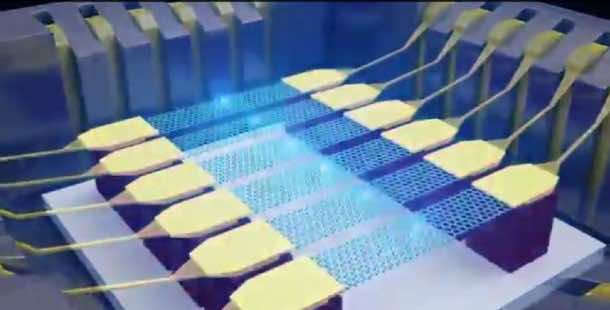More than 130 years ago, Thomas Edison made use of carbon as a conducting filament and created the first commercial light bulb. Now, A team of engineers and scientists has made use of the same element in its perfect crystalline form – graphene – to create world’s thinnest light bulb. It is merely one atom thick and covers an area that is too small to be seen by naked eye, however, generates light bright enough that it can be seen with the naked eye.
The team was comprised of engineers and researchers from Columbia University, Seoul National University (SNU) and Korea Research Institute of Standards and Science (KRISS). It created the gadget by making use of filaments of graphene that were attached to metal electrodes. The strips were then suspended above a silicon substrate and upon passing of electric current, the filaments got heated up to more than 2,500° C and produced an exceptionally bright light.
James Hone, Professor of Mechanical Engineering at Columbia said, “We’ve created what is essentially the world’s thinnest light bulb. This new type of ‘broadband’ light emitter can be integrated into chips and will pave the way towards the realization of atomically thin, flexible, and transparent displays, and graphene-based on-chip optical communications.”
How can graphene reach such intense temperatures and not melt? Graphene, as it heats up loses the ability to conduct heat away from itself and as a result, the concentration of the heat is limited to the center of the filaments and this produces light that is quite intense.
Myung-Ho Bae, a senior researcher at KRISS said, “At the highest temperatures, the electron temperature is much higher than that of acoustic vibrational modes of the graphene lattice, so that less energy is needed to attain temperatures needed for visible light emission. These unique thermal properties allow us to heat the suspended graphene up to half of the temperature of the sun, and improve efficiency 1,000 times, as compared to graphene on a solid substrate.”
The team is working on improving the performance of these devices to find out how quickly they can be switched on and off in order to make use of them in optical communication. Professor Hone further added, “We are just starting to dream about other uses for these structures – for example, as micro-hotplates that can be heated to thousands of degrees in a fraction of a second to study high-temperature chemical reactions or catalysis.”
Results of this research were published in the journal Nature Nanotechnology.


